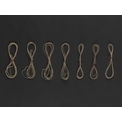
- Unnamed silk strings(produced in the 1970s-1980s) (1)
Each string is separately tied with a red thread in the middle to form the shape of the numeral “8”. The top and the bottom of the numeral “8” are tightly tied with a red thread to form a set. Packed in transparent plastic bags.
The exhibits in this photo are thick strings. The first to the fourth strings are wound, tied with a green thread at the head. The fifth to the seventh strings are not wound.
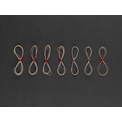
- Unnamed silk strings(produced in the 1970s-1980s) (2)
Each string is separately tied with a red thread in the middle to form the shape of the numeral “8”. The top and the bottom of the numeral “8” are tightly tied with a red thread to form a set. Packed in transparent plastic bags.
The exhibits in this photo in this photo are thin strings. The first to the fourth strings are wound, tied with a green thread at the head. The fifth to the seventh strings are not wound.
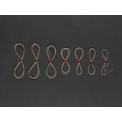
- Unnamed silk strings(produced in the 1970s-1980s) (3)
Each string is separately tied with a red thread in the middle to form the shape of the numeral “8”. The top and the bottom of the numeral “8” are tightly tied with a red thread to form a set. Packed in transparent plastic bags.
The exhibits in this photo are thick strings. The first to the third strings are wound. The first is tied with a red thread at the head, the second with a pink thread, and the third with a white thread. The fourth to the seventh strings are not wound. The set of strings of which the fourth is not wound is rarely seen in modern times.
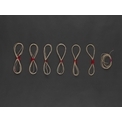
- Unnamed silk strings(produced in the 1970s-1980s) (4)
Each of the first to seventh strings is separately tied with a red thread in the middle to form the shape of the numeral “8”. The top and the bottom of the numeral “8” are tightly tied with a red thread to form a set. Packed in transparent plastic bags.
The exhibits in this photo are thick strings. The first to the fourth strings are wound. The first is tied with a red thread at the head, the second with a blue thread, the third with a white thread, and the fourth with a green thread. The fifth to the seventh strings are not wound.
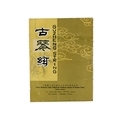
- Guqin string wrapping converted from a guzheng string wrapping (1)
This is originally a wrapping for guzheng strings, produced by the Tianjin branch of the China National Light Industrial Product Import and Export Corporation between 1970s and 1980s. But the character “zheng” on the wrapping is covered with a piece of paper with the character “qin” written on it, so the wrapping became that for qin strings. The replacing character was carefully written in the original official script. We can no longer trace whether this was done by the manufacturer, the seller or the user.
There is this description at the back of the wrapping, “The strings, both silk and metal, manufactured in this factory, for musical instruments, are made of the materials of the best quality by skilful workers under strict supervision of the specialists.” This is a proof that silk strings have been produced in Tianjin, although we cannot say for sure whether the silk strings produced were the strings tied with coloured threads. This was formerly in the collection of Tsar Teh-yun.
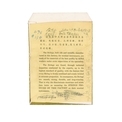
- Guqin string wrapping converted from a guzheng string wrapping (2)
This is originally a wrapping for guzheng strings, produced by the Tianjin branch of the China National Light Industrial Product Import and Export Corporation between 1970s and 1980s. But the character “zheng” on the wrapping is covered with a piece of paper with the character “qin” written on it, so the wrapping became that for qin strings. The replacing character was carefully written in the original official script. We can no longer trace whether this was done by the manufacturer, the seller or the user.
There is this description at the back of the wrapping, “The strings, both silk and metal, manufactured in this factory, for musical instruments, are made of the materials of the best quality by skilful workers under strict supervision of the specialists.” This is a proof that silk strings have been produced in Tianjin, although we cannot say for sure whether the silk strings produced were the strings tied with coloured threads. This was formerly in the collection of Tsar Teh-yun.
